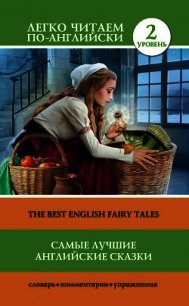English Fairy Tales - Jacobs Joseph (бесплатная регистрация книга .txt) 📗
VII. NIX NOUGHT NOTHING.
Source.–From a Scotch tale, “Nicht Nought Nothing,” collected by Mr. Andrew Lang in Morayshire, published by him first in Revue Celtique, t. iii; then in his Custom and Myth, p. 89; and again in Folk-Lore, Sept. 1890. I have changed the name so as to retain the equivoque of the giant’s reply to the King. I have also inserted the incidents of the flight, the usual ones in tales of this type, and expanded the conclusion, which is very curtailed and confused in the original. The usual ending of tales of this class contains the “sale of bed” incident, for which see Child, i. 391.
Parallels.–Mr. Lang, in the essay “A Far-travelled Tale” in which he gives the story, mentions several variants of it, including the classical myth of Jason and Medea. A fuller study in Cosquin, l.c., ii. 12-28. For the finger ladder, see Kohler, in Orient and Occident, ii. III.
VIII. JACK HANNAFORD.
Source.–Henderson’s Folk-Lore of Northern Counties (first edition), p. 319. Communicated by the Rev. S. Baring-Gould.
Parallels.–"Pilgrims from Paradise” are enumerated in Clouston’s Book of Noodles, pp. 205, 214-8. See also Cosquin, l.c., i. 239.
IX. BINNORIE.
Source.–From the ballad of the “Twa Sisters o’ Binnorie.” I have used the longer version in Roberts’s Legendary Ballads, with one or two touches from Mr. Allingham’s shorter and more powerful variant in The Ballad Book. A tale is the better for length, a ballad for its curtness.
Parallels.–The story is clearly that of Grimm’s “Singing Bone" (No. 28), where one brother slays the other and buries him under a bush. Years after a shepherd passing by finds a bone under the bush, and, blowing through this, hears the bone denounce the murderer. For numerous variants in Ballads and Folk Tales, see Prof. Child’s English and Scotch Ballads (ed. 1886), i. 125, 493; iii. 499.
X. MOUSE AND MOUSER.
Source.–From memory by Mrs. E. Burne-Jones.
Parallels.–A fragment is given in Halliwell, 43; Chambers’s Popular Rhymes has a Scotch version, “The Cattie sits in the Kilnring spinning” (p. 53). The surprise at the end, similar to that in Perrault’s “Red Riding Hood,” is a frequent device in English folk tales. (Cf. infra, Nos. xii., xxiv., xxix., xxxiii., xli.)
XI. CAP O’ RUSHES.
Source.–Discovered by Mr. E. Clodd, in “Suffolk Notes and Queries” of the Ipswich Journal, published by Mr. Lang in Longinan’s Magazine, vol. xiii, also in Folk-Lore, Sept. 1890.
Parallels.–The beginning recalls “King Lear.” For “loving like salt,” see the parallels collected by Cosquin, i. 288. The whole story is a version of the numerous class of Cinderella stories, the particular variety being the Catskin sub-species analogous to Perrault’s Peau d’Ane. “Catskin” was told by Mr. Burchell to the young Primroses in “The Vicar of Wakefield,’” and has been elaborately studied by the late H. C. Coote, in Folk-Lore Record, iii. 1-25. It is only now extant in ballad form, of which "Cap o’ Rushes” may be regarded as a prose version.
XII. TEENY-TINY.
Source.–Halliwell, 148.
XIII. JACK AND THE BEANSTALK.
Source.–I tell this as it was told me in Australia, somewhere about the year 1860.
Parallels.–There is a chap-book version which is very poor; it is given by Mr. E. S. Hartland, English Folk and Fairy Tales (Camelot Series), p. 35, seq. In this, when Jack arrives at the top of the Beanstalk, he is met by a fairy, who gravely informs him that the ogre had stolen all his possessions from Jack’s father. The object of this was to prevent the tale becoming an encouragement to theft! I have had greater confidence in my young friends, and have deleted the fairy who did not exist in the tale as told to me. For the Beanstalk elsewhere, see Ralston, Russian Folk Tales, 293-8. Cosquin has some remarks on magical ascents (i. 14).
XIV. THREE LITTLE PIGS.
Source.–Halliwell, p. 16.
Parallels.–The only known parallels are one from Venice, Bernoni, Trad. Pop., punt. iii. p. 65, given in Crane, Italian Popular Tales, p. 267, “The Three Goslings;” and a negro tale in Lippincott’s Magazine, December, 1877, p. 753 ("Tiny Pig”).
Remarks.–As little pigs do not have hair on their chinny chin- chins, I suspect that they were originally kids, who have. This would bring the tale close to the Grimms’ “Wolf and Seven Little Kids,” (No. 5). In Steel and Temple’s “Lambikin” (Wide-awake Stories, p. 71), the Lambikin gets inside a Drumikin, and so nearly escapes the jackal.
XV. MASTER AND PUPIL
Source.–Henderson, Folk-Lore of Northern Counties, first edition, p. 343, communicated by the Rev. S. Baring-Gould. The rhymes on the open book have been supplied by Mr. Batten, in whose family, if I understand him rightly, they have been long used for raising the––; something similar occurs in Halliwell, p. 243, as a riddle rhyme. The mystic signs in Greek are a familiar “counting-out rhyme”: these have been studied in a monograph by Mr. H. C. Bolton; he thinks they are “survivals” of incantations. Under the circumstances, it would be perhaps as well if the reader did not read the lines out when alone. One never knows what may happen.
Parallels.–Sorcerers’ pupils seem to be generally selected for their stupidity–in folk-tales. Friar Bacon was defrauded of his labour in producing the Brazen Head in a similar way. In one of the legends about Virgil he summoned a number of demons, who would have torn him to pieces if he had not set them at work (J. S. Tunison, Master Virgil, Cincinnati, 1888, p. 30).
XVI. TATTY MOUSE AND TATTY MOUSE.
Source.–Halliwell, p. 115.
Parallels.–This curious droll is extremely widespread; references are given in Cosquin, i. 204 seq., and Crane, Italian Popular Tales, 375-6. As a specimen I may indicate what is implied throughout these notes by such bibliographical references by drawing up a list of the variants of this tale noticed by these two authorities, adding one or two lately printed. Various versions have been discovered in:
ENGLAND: Halliwell, Nursery Rhymes, p. 115.
SCOTLAND: K. Blind, in Arch. Rev. iii. ("Fleakin and Lousikin," in the Shetlands).
FRANCE: Melusine, 1877, col. 424; Sebillot, Contes pop. de la Haute Bretagne, No. 55, Litterature orale, p. 232; Magasin picturesque, 1869, p. 82; Cosquin, Contes pop. de Lorraine, Nos. 18 and 74.
ITALY: Pitre, Novelline popolari siciliane, No. 134 (translated in Crane, Ital. Pop. Tales, p. 257); Imbriani, La novellaja Fiorentina, p. 244; Bernoni, Tradizione popolari veneziane, punt. iii. p. 81; Gianandrea, Biblioteca delle tradizioni popolari marchigiane, p.,11; Papanti, Novelline popolari livornesi, p. 19 ("Vezzino e Madonna Salciccia”); Finamore, Trad. pop. abruzzesi, p. 244; Morosi, Studi sui Dialetti Greci della Terra d’Otranto, p. 75; Giamb. Basile, 1884, p. 37.
GERMANY: Grimm, Kinder- und Hausmarchen, No. 30; Kuhn and Schwarz, Norddeutsche Sagen, No. 16.
NORWAY: Asbjornsen, No. 103 (translated in Sir G. Dasent’s Tales from the Field, p. 30, “Death of Chanticleer”).


